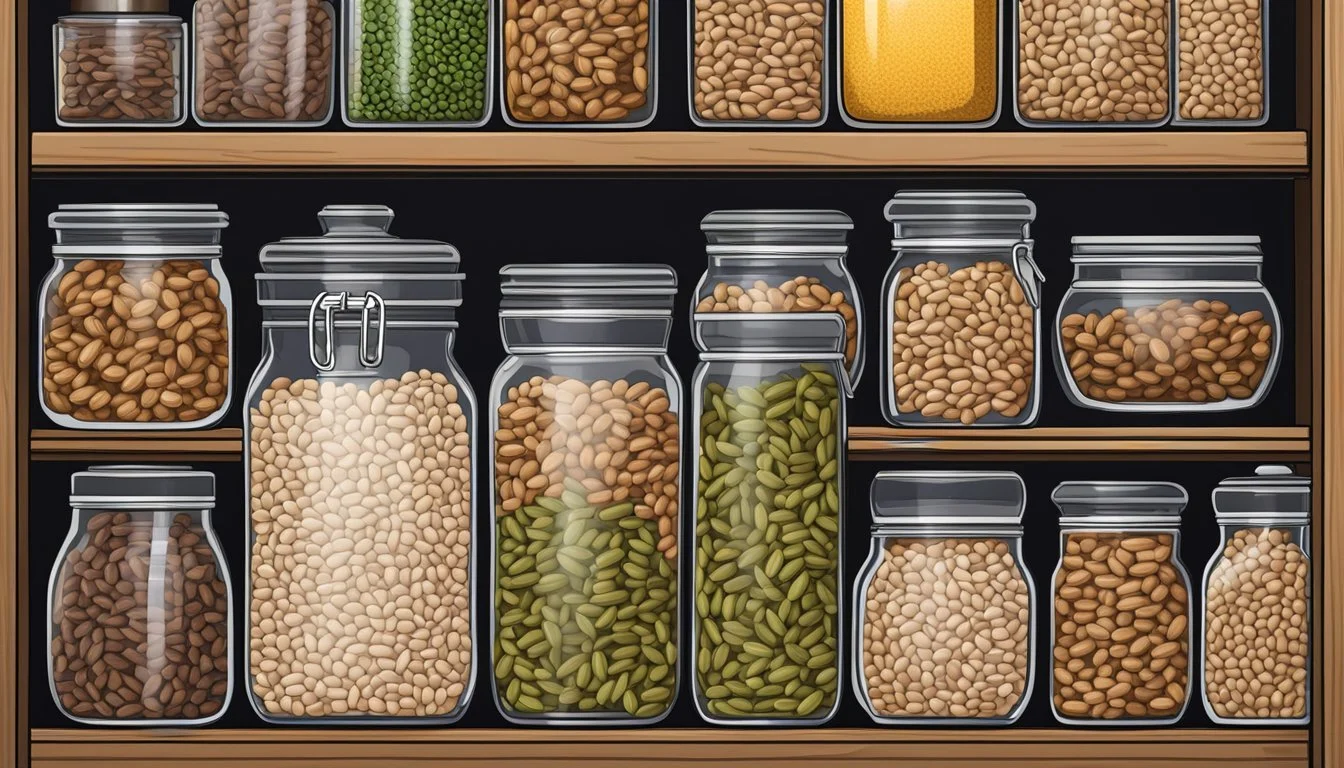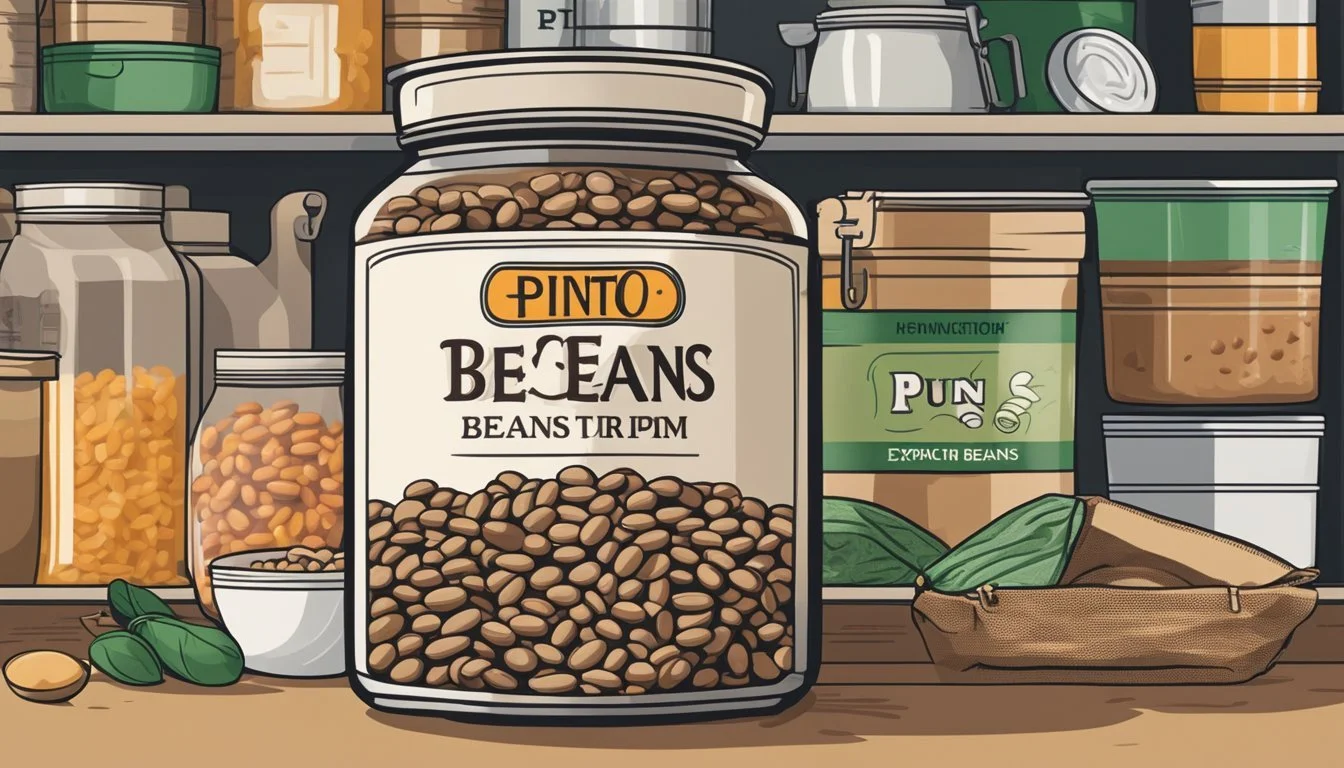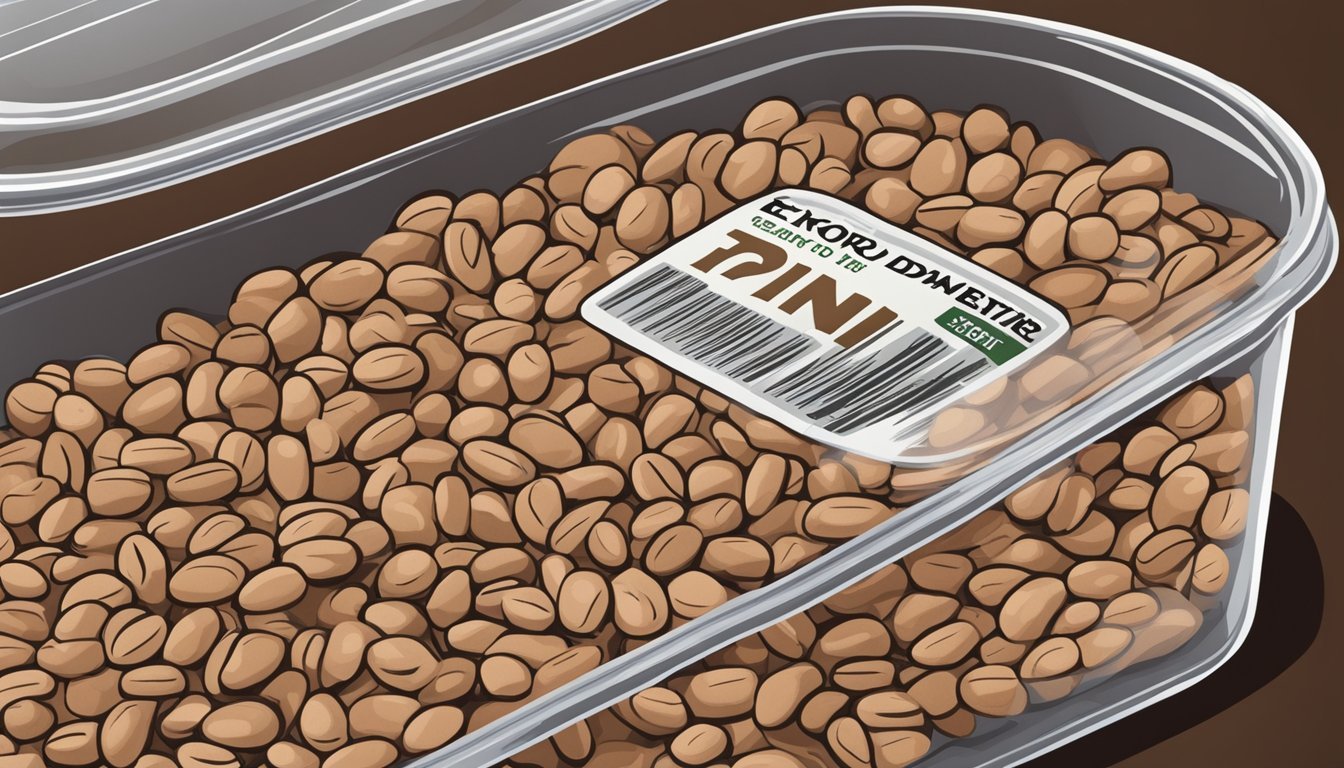How Long Do Pinto Beans Last?
Shelf Life and Storage Tips
Pinto beans are a staple in many pantries due to their versatility and nutritional value. They are known for their creamy texture and earthy flavor, which makes them a popular choice for a variety of dishes, including soups, stews, and refried beans. The shelf life of pinto beans, like most legumes, depends heavily on the storage conditions. When stored properly in a cool, dry place, and ideally in an airtight container, dried pinto beans can last for up to one to two years. Good storage practices are essential to preserve their quality and prevent spoilage.
Once cooked, pinto beans' shelf life is considerably shorter. In the refrigerator, cooked pinto beans should remain good for approximately three to five days. Proper cooling and storage in airtight containers are crucial to maximizing their shelf life in the fridge. Cooked beans will make their spoilage apparent through a sour odor or a slimy texture, signaling that they are no longer fit for consumption.
Understanding the proper storage methods for pinto beans can ensure that they retain their taste and nutritional benefits for as long as possible. It also helps in reducing food waste by avoiding premature spoilage. Whether in their dried form or cooked, paying attention to storage conditions can keep these beans as a ready-to-use ingredient in one's cooking repertoire.
Identifying Pinto Beans
Pinto beans are a variety of common beans (Phaseolus vulgaris). In their dried form, they exhibit a beige background stippled with reddish-brown splotches. This mottled appearance gives them their name, as "pinto" in Spanish means "painted." When cooked, these beans turn a uniform brown color and have a creamy texture.
Physical Characteristics:
Color: Beige with reddish-brown spots (dry), uniform brown (cooked)
Texture: Smooth, creamy when cooked
Shape: Oval and slightly curved
Dried pinto beans are a staple in many pantries, and they're an integral part of the legume family. They provide a high protein content, making them an excellent choice for vegetarian and vegan diets.
Nutritional Profile:
High in protein
Rich in fiber
Contain essential nutrients like iron and potassium
When sorting and preparing these legumes, it's important to look for intact skins and to discard any beans that appear shriveled or discolored. A fresh, quality pinto bean should be firm to the touch and should not split when handled gently.
Storage Tips:
Keep dried pinto beans in a cool, dry place.
Use an airtight container for extended shelf life.
Pinto beans are versatile in their use. They can be prepared in a multitude of dishes, including soups, stews, and the traditional refried beans. Recognizing and selecting high-quality pinto beans is straightforward once familiar with their distinct coloration and texture.
Storage Basics
When it comes to the longevity of pinto beans, proper storage plays a pivotal role. Pinto beans should be stored in a cool, dry place to maintain their quality. A pantry or a cupboard away from heat sources is ideal. They must be kept in an environment where the temperature is consistent and the air is dry to prevent degradation of the beans.
One should ensure that the pinto beans are placed in an airtight container to shield them from moisture and pests. A container with a tight-sealing lid is recommended. Keeping the beans in a container also protects them from absorbing strong odors, as beans are porous and can take on the smells of other foods.
Light exposure can shorten the shelf life of pinto beans, so it's advisable to store them in opaque containers or within areas shielded from direct light. This is particularly crucial for food storage over extended periods.
Preventing Moisture: Ensure that the storage area for the beans is free from moisture, as damp conditions can encourage mold growth and spoilage.
It should be noted that while pinto beans can be stored for a long time, they do not last indefinitely. Over time, the beans may lose some of their nutritional value and may not cook up as well.
Food Storage Guidelines:
Store in a cool, dry place.
Use airtight containers.
Limit exposure to light.
Keep the beans in a stable environment free from moisture.
Properly adhering to these storage basics ensures pinto beans remain a reliable and resilient staple in one's food reserves.
Shelf Life of Pinto Beans
Understanding the shelf life of pinto beans is essential to maintaining their quality and ensuring food safety. Storage conditions play a critical role in the longevity of both dried and cooked pinto beans.
Dried Pinto Beans
Dried pinto beans have a notable shelf life if stored properly. Ideally, they should be kept in an airtight container in a cool, dark place like a pantry. Under these conditions, the beans can last well, typically ranging from one to two years. It is the quality of dried beans that begins to diminish over time—older beans may require longer cooking times and may not become as tender as fresher beans. Signs of spoilage to look out for include mold, unusual odors, insect infestation, or changes in color, texture, or appearance.
Cooked Pinto Beans
Once cooked, pinto beans' shelf life is greatly shortened. Keeping them refrigerated is imperative for food safety. Cooked pinto beans should ideally be stored in a sealed container in the refrigerator and are best if consumed within three to five days. Quality degradation in cooked beans (how long do cooked beans last?) is often detectable by changes in smell, texture, or color. Any indication of spoilage such as mold growth or sour smell means the beans should be discarded.
Factors Affecting Longevity
When considering the shelf life of pinto beans, several key factors can influence their longevity:
Storage Temperature: Beans stored in a cool environment last longer. Elevated temperatures can quicken degradation and reduce shelf life.
Moisture Exposure: Beans should be kept in a dry place. Moisture can lead to spoilage through mold growth and bacterial development.
Container Seal: Using an airtight container is crucial. It minimizes exposure to air and prevents the oxidation process that can degrade the quality of the beans.
Light Exposure: Beans last longer when stored away from light, preferably in a dark place like a pantry. Light can induce photo-oxidation, which affects flavor and nutritional value.
Storage Method: As for cooked pinto beans, storing them in the freezer can significantly extend their shelf life compared to refrigeration.
In practice, these factors affect the storage times as follows:
Factor Ideal Condition Effect on Longevity Temperature Cool, stable environment (pantry, cupboard) Preserves quality and extends shelf life Moisture Dry surroundings, low humidity Deters mold and bacteria, prevents spoilage Container Seal Airtight seal, limited air exposure Slows down oxidation Light Dark place, minimal light exposure Protects from photo-oxidation Storage Method Dry beans in airtight containers, cooked beans in freezer Maximizes dry and cooked beans longevity
Adhering to these guidelines ensures the longest possible shelf life for pinto beans.
Signs of Spoilage
Detecting spoiled pinto beans involves assessing their appearance and smell. These sensory checks are crucial for determining whether the beans are safe for consumption or need to be discarded.
Visual Indicators
Spoiled pinto beans often exhibit visible changes that indicate they are no longer fit for consumption. If one observes moldy spots or discoloration, it's likely that the beans have been compromised. The presence of insects or bugs within the package also necessitates discarding the beans, as these pests can contaminate and damage the product.
Olfactory Indicators
Spoiled beans will emit an off odor that sharply contrasts with their normally subtle, earthy scent. Any bad or unusual smells are clear indicators that the pinto beans have gone bad and should be discarded to avoid the risks of foodborne illness.
Maximizing Shelf Life
Proper storage methods can significantly lengthen the shelf life of pinto beans, whether they are in their dried state or have been cooked. Ensuring beans are kept in optimal conditions preserves their quality and edibility.
For Dried Beans
Dried pinto beans should be stored in a cool, dry place, away from direct sunlight. Placing them in an airtight container, such as a glass jar or plastic container with a secure lid, prevents moisture and pests from compromising the beans. To further extend their longevity, one may consider utilizing oxygen-free packaging. If dried beans are stored correctly, they can remain edible for many years, although their quality is best when they are fresh. Pinto beans generally maintain their best quality for 2 to 3 years at room temperature. However, for long-term storage, some findings suggest that they can last for 25 to 30 years under ideal conditions.
For Cooked Beans
Once cooked, pinto beans' shelf life is considerably shorter. They should be stored in the refrigerator in shallow airtight containers or resealable plastic bags to maximize freshness. It's important to refrigerate them within two hours of cooking to prevent bacterial growth. Cooked pinto beans typically last for 3 to 5 days in the refrigerator. For longer storage, cooked beans can be frozen. To freeze pinto beans, one should let them cool, drain well, and then place them in airtight containers or freezer bags, squeezing out as much air as possible before sealing. When properly stored in the freezer, they can be safely consumed for several months, though the sooner they are used, the better they will taste.
Health and Nutrition
Pinto beans are a nutritious addition to a healthy diet. They contain a significant amount of protein, making them a staple, especially in vegan and vegetarian diets. One cup of cooked pinto beans typically provides about 15 grams of protein, which is essential for muscle repair and growth.
They are also an excellent source of dietary fiber, with approximately 15 grams per cup. Fiber aids in digestion, helps maintain blood sugar levels, and can support weight management by creating a feeling of fullness.
In terms of vitamins and minerals, pinto beans are rich in various nutrients. They house a considerable amount of folate (vitamin B9), offering roughly 294 micrograms per cup. Folate is pivotal for DNA synthesis and repair. Additionally, iron content stands at about 3.6 milligrams per serving, which is integral in preventing anemia and supporting healthy blood circulation.
Here is a quick glance at the nutritional value of pinto beans:
Protein: 15g per cup (cooked)
Fiber: 15g per cup (cooked)
Folate: 294mcg per cup (cooked)
Iron: 3.6mg per cup (cooked)
Including pinto beans in one's diet can contribute to the intake of a variety of nutrients that are essential for good health. Regular consumption as part of a balanced diet can offer multiple health benefits, such as the maintenance of a healthy cardiovascular system and the potential to lower cholesterol levels. In addition to being nutrient-dense, pinto beans are a low-fat food, aligning well with a healthy diet approach.
Preparation and Usage
Before one can enjoy the hearty and nutritious offerings of pinto beans, understanding their preparation and the various cooking methods is essential. This section provides details on how to cook pinto beans and offers a selection of recipe ideas to inspire delicious meals.
Cooking Methods
When preparing dried beans, soaking them overnight can expedite the cooking process and may make the beans easier to digest. However, this step can be omitted if time is short; it will simply require a longer cooking duration.
Slow Cooker: For a hands-off approach, pinto beans can be cooked in a slow cooker. Combine the beans with water or stock and spices, and cook on low for 6-8 hours or on high for 3-4 hours until tender.
Dutch Oven: To cook pinto beans in a Dutch oven, first, sauté desired seasonings such as garlic and onions, then add the beans and cover with water. Bring to a boil, reduce the heat, and simmer for 2-4 hours.
Recipe Ideas
Pinto beans are a versatile ingredient that can be incorporated into a multitude of recipes. Their creamy texture and mild flavor make them an excellent canvas for a variety of spices and seasonings.
Chili: Pinto beans are a staple in many chili recipes. They absorb flavors well and contribute to the dish's hearty consistency.
Bean Soup: They make for a nourishing addition to soups, particularly when combined with vegetables and a savory broth.
Bean Casserole and Baked Beans: In casseroles and baked beans dishes, pinto beans hold their shape and provide a satisfying, protein-rich component.
Refried Beans and Bean Dip: For Tex-Mex cuisine, pinto beans can be mashed and fried to create refried beans or used in a flavorful bean dip.
Whether acting as the focal point or a complimentary ingredient, pinto beans can enhance a meal with both texture and nutrition.
Troubleshooting Common Issues
When preparing and storing pinto beans, one might encounter a range of common issues affecting cooking quality and shelf life. This section seeks to provide solutions to problems that may arise with cooking and storage.
Cooking Problems
Cooking pinto beans could lead to several issues affecting their taste and texture. Strategies to circumvent these problems include:
Not Fully Cooked: If beans remain hard after cooking, they may require more time. Ensure they are simmered gently until tender.
Overcooking: Overcooked beans can become mushy. To avoid this, one should start checking the beans for doneness well before the end of the suggested cooking time.
Storage Challenges
Storage challenges can impact the shelf life and safety of pinto beans, whether dried or cooked. Specific storage solutions are:
Dry Beans: Store dried pinto beans in a cool, dark place in airtight containers to prevent loss of nutritional value and to extend shelf life.
Storage Location Expected Shelf Life Pantry Up to 2-3 years Refrigerator Not recommended Freezer Not necessary
Cooked Beans: After cooking, pinto beans must be stored properly to prevent bacterial growth.
Refrigeration: Store in airtight containers or resealable plastic bags and consume within 3-5 days.
Freezing: For longer storage, one can freeze the beans. Ensure beans are cooled before storing and use within 6 months for best quality.
Reheating: When reheating, ensure the beans reach 165°F to kill any potential bacteria.
Food Safety Considerations
When it comes to pinto beans, understanding food safety is crucial to prevent foodborne illness and spoilage. Cooked pinto beans should be refrigerated within two hours of cooking to inhibit the growth of bacteria. The ideal temperature is below 40°F. Cooked beans should be stored in shallow airtight containers or resealable plastic bags to maximize freshness and safety.
In the refrigerator, cooked pinto beans typically last for 3 to 5 days. If one needs to extend their shelf life, freezing is an option. To freeze pinto beans, one should ensure they are cooled first, then stored in freezer-safe bags or containers. Properly frozen pinto beans can last up to 6 months. However, the texture may change once thawed; thus, they're best used in cooked dishes.
Uncooked dried pinto beans, on the other hand, should be kept in a cool, dark place in an airtight container. They remain safe to consume for up to 1 to 2 years. It's important to regularly check for signs of spoilage, such as a musty smell or dampness before cooking, as these indicate that the beans should be discarded.
Spoilage and Bacteria: Beans are susceptible to bacterial growth when kept at room temperature for too long. If cooked beans have been at room temperature for over two hours, they should be discarded. Beans that show signs of spoilage, such as mold, off smells, or a slimy texture, should also be thrown out, regardless of their refrigeration or freezing status.
By following these guidelines, one can ensure their pinto beans remain safe to eat and reduce the risk of foodborne illnesses.
FAQs About Pinto Beans
How long can dried pinto beans be stored?
Dried pinto beans have a long shelf life when stored correctly. They should be kept in a cool, dark place, ideally in an airtight container. Under these conditions, they can last for about 1 to 2 years.
What is the shelf life of cooked pinto beans in the fridge?
Once cooked, pinto beans can stay fresh in the refrigerator for up to 5 days. They should be placed in an airtight container to maintain their flavor and nutrients.
Can cooked pinto beans be frozen?
Yes, freezing cooked pinto beans is an effective method to extend their shelf life. Beans can be frozen for up to 6 months. To prevent freezer burn, store them in a tightly sealed container or freezer bag.
How does one determine if pinto beans have gone bad?
Signs that pinto beans are no longer edible include a sour smell, discoloration, and a slimy texture. If these signs are present, the beans should not be consumed.
Does freezing pinto beans affect their nutritional value?
Freezing should not significantly affect the nutritional value. Pinto beans retain most of their nutrients when frozen, making them a healthy, long-term storage option.
Storage Method Shelf Life Pantry (dried) 1-2 Years Refrigerator (cooked) Up to 5 Days Freezer (cooked) Up to 6 Months
For optimal flavor and nutrient retention, it is important to adhere to these storage guidelines. Proper storage ensures that pinto beans remain a nutritious and versatile component of any meal.











